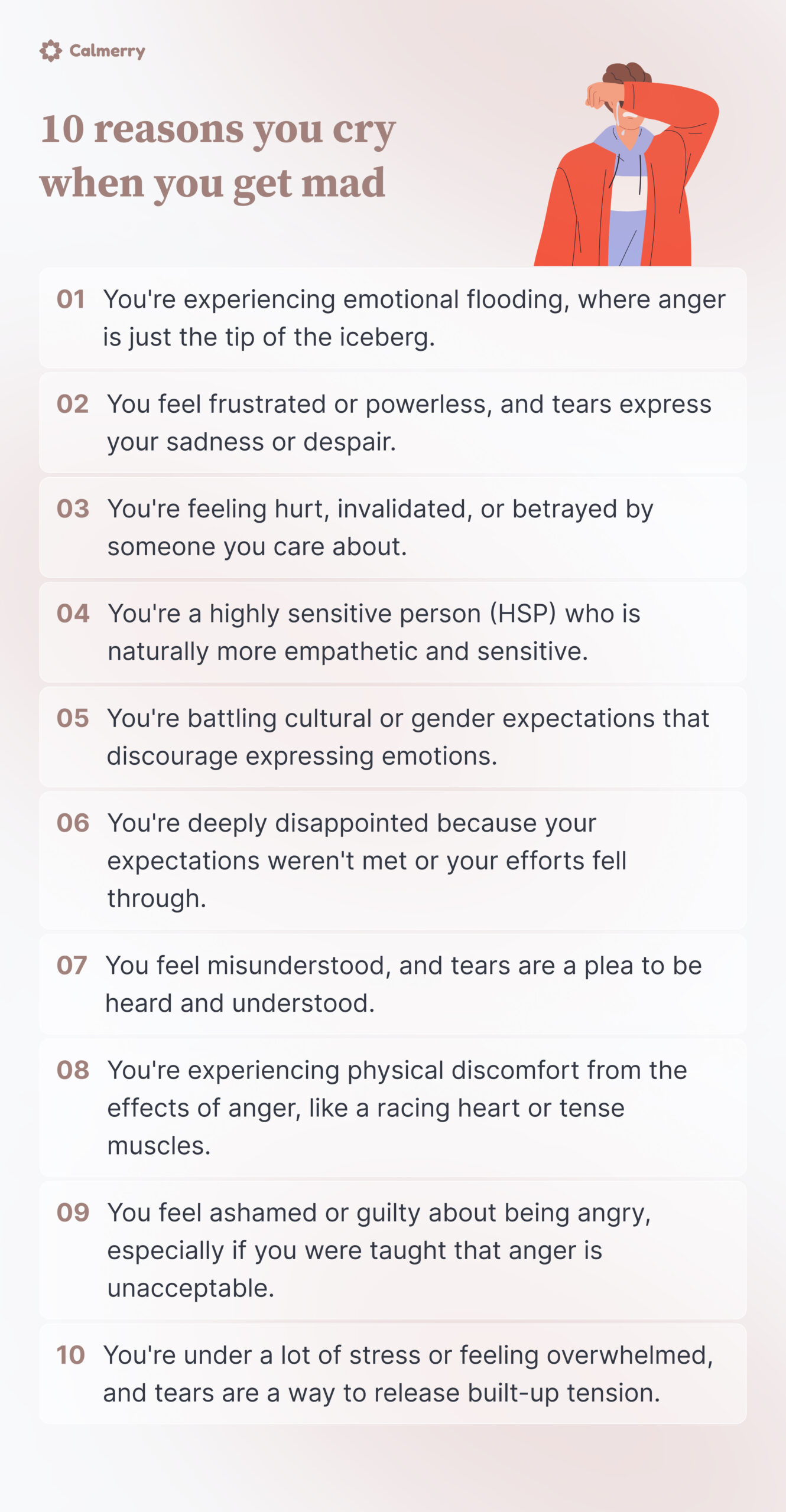Why Do I Cry When I Get Mad? – 10 Reasons and How to Cope

In this article
Have you ever found yourself welling up with tears during an argument? You’re not alone.
Many people experience the phenomenon of crying when they’re angry. It can be confusing, frustrating, and even a little embarrassing.
But what if we told you that crying during anger is a normal and healthy response?
In this article, we’ll explore why this happens, debunk the stigma surrounding emotional tears, and equip you with strategies to manage those “angry cries” and communicate effectively even when emotions run high.
So, grab a tissue (or two) and dive in – it’s time to break free from the cycle of frustration and finally understand “Why do I cry when I get mad”!
10 reasons you cry when you get mad

Crying during anger can be frustrating, confusing, and even embarrassing. But it’s a normal reaction!
Here are some specific reasons why you might cry when you’re feeling mad:
1. Emotional flooding
Anger can be like a dam holding back a reservoir of other emotions. When the dam breaks, it can lead to a flood of tears alongside anger.
This might be especially true if you’ve been suppressing your feelings for long or the situation triggers past hurts.
Past traumas or unresolved issues can intensify emotional flooding, making you more likely to cry when angry.
2. Frustration and powerlessness
Sometimes anger stems from feeling frustrated or powerless. You might cry because you see no way to change things or make yourself heard.
The tears can express a profound sense of sadness or despair.
Feeling powerless can be especially triggering if you’ve experienced situations in the past where you had little control.
3. Feeling hurt, invalidated, or betrayed
Often, anger is sparked by feeling hurt or betrayed by someone you care about. Tears can be a way of expressing that emotional pain alongside anger at the situation.
Besides, if you express your anger and the other person minimizes or dismisses your feelings, it can be deeply hurtful and lead to tears. You might cry out of frustration that your perspective isn’t being respected.
4. High sensitivity
Some people are naturally more empathetic and sensitive to the emotions of others. This is called a highly sensitive person, or HSP.
If you fall into this category, you might cry out of compassion or concern for the person you’re angry with or even yourself in a tense situation.
HSPs may also be more easily overwhelmed by sensory stimuli, which can contribute to emotional responses like crying.
5. Cultural or gender expectations
Societal norms can influence how we express emotions. Crying might be seen as a weakness, especially for people assigned male at birth.
This can lead to a confusing internal battle where you feel angry and pressured to suppress emotions, which can manifest as tears.
6. Disappointment
Disappointment can cut deep and sometimes trigger angry tears. You might cry because you feel your expectations weren’t met or you invested a lot of time or energy into something that fell through.
The crying response to disappointment can be influenced by how much you were counting on or emotionally invested in the expected outcome.
7. Feeling misunderstood
If you feel your anger is being dismissed or misunderstood, it can be incredibly frustrating and lead to tears. Tears can be an expression of that frustration and a plea to be heard and understood.
8. Physical discomfort
The physical effects of anger, like a racing heart or tense muscles, can be uncomfortable and even scary. Crying can be a way to release that physical tension and signal that you’re feeling overwhelmed.
9. Feeling ashamed or guilty
Sometimes, anger can be directed inward, causing feelings of shame or guilt. You might cry because you feel bad about being angry or think you shouldn’t feel the way you do.
This can be especially true if you were taught that anger is wrong or unacceptable.
10. Stress and overwhelm
When you’re under a lot of stress or feeling overwhelmed, even small triggers can lead to intense emotions like anger and crying. The tears may be a way for your body to release built-up tension and stress.
As you can see, there are many reasons why anger might manifest as tears. This emotional response is valid and doesn’t diminish the strength or legitimacy of your anger.
By understanding the reasons behind your angry tears, you can develop coping mechanisms and communication strategies that will empower you to express yourself effectively, even in the most heated moments.
– Veronica Silver, Therapist-turned mental health writer
Strategies to manage crying when you’re mad
While crying during anger is normal, it can sometimes feel disruptive or embarrassing, especially in certain situations.
Here are some short- and long-term strategies to help you manage crying when you’re mad:
What to do in the moment
- Acknowledge your feelings. Don’t judge yourself for crying. Tell yourself, “It’s okay to feel this way,” and take a deep breath. Recognizing your emotions can be the first step to calming down.
- Take a time-out. If you feel tears welling up, excuse yourself from the situation. Splash cold water on your face, step outside for fresh air, or find a quiet space to collect yourself.
- Focus on your breath. Deep breathing exercises can be a powerful tool to calm your nervous system and regain control of your emotions. Try inhaling slowly through your nose for a count of four, holding for a count of four, and exhaling slowly out of your mouth for a count of eight. Repeat this several times until you feel calmer.
- Try Progressive Muscle Relaxation. Tense and relax different muscle groups in your body. Starting with your toes and working your way up. This can help release physical tension and promote relaxation.
Long-term strategies
- Identify your triggers. Pay attention to situations that typically lead to angry tears. Are there specific topics, people, or environments that push your buttons? Once you recognize your triggers, you can develop effective coping strategies to deal with them.
- Practice assertive communication. When angry, try to communicate your needs and feelings calmly and assertively. Many resources are available to help you develop assertive communication skills.
- Consider therapy. A therapist can help you understand your emotional responses and develop healthy coping mechanisms for dealing with anger and other strong emotions.
- Self-care. Make sure you’re taking care of yourself physically and emotionally. This includes getting proper sleep, eating a balanced diet, regular exercise, and engaging in enjoyable activities.
You are not alone in this. By acknowledging your emotions, developing coping mechanisms, and practicing self-care, you can learn to manage crying and communicate effectively even when you’re feeling angry.
How to communicate you’re mad even though you’re crying
Crying when you’re mad can make communication challenging. It can be difficult to form thoughts or communicate effectively when you’re worrying about “Why am I crying when talking about my feelings?”
The good news is it’s still possible to express your frustrations and needs effectively, even with tears. Here are some tips:
Acknowledge your emotions
Let the other person know you’re upset and explain that you might cry while talking.
Phrases like “I’m feeling really angry about this, and I might tear up while I explain why” or “This situation is making me emotional, but I still want to communicate my feelings” can set the stage for a more understanding conversation.
Focus on “I”-statements
Instead of accusatory statements (“You always do this!“), use “I”-statements to express how the situation is impacting you (“I feel hurt when…” or “I get frustrated when…” ).
This will focus on your feelings and reduce the other person’s defensiveness.
Take breaks
If you feel overwhelmed by tears, take a short break to compose yourself. Explain that you need a moment and return when you feel ready to continue.
Stepping away shows you’re committed to the conversation and prioritizing your ability to communicate clearly.
Focus on the issue, not the crying
While acknowledging your tears, keep the conversation focused on the problem. Phrases like “Even though I’m crying, what I need is…” or “My tears don’t change the fact that…” can help refocus the conversation.
Validate your feelings
Crying doesn’t diminish the validity of your anger. Remind yourself (and maybe even say it out loud) that your feelings are important and deserve to be heard.
– Veronica Silver, Therapist-turned mental health writer
Open and honest communication is critical. Acknowledging your emotions, using clear language, and focusing on the issue can help you have a productive conversation, even when crying or discussing your feelings.
How to cope with being embarrassed about angry crying
It’s perfectly normal to feel embarrassed when crying during anger. Our society often stigmatizes emotional expression, especially tears, as a sign of weakness.
However, crying is a natural response; there are ways to manage that embarrassment and improve your emotional well-being.
Challenge the stigma
Remind yourself that crying is a normal human response. Suppressing emotions can be more harmful in the long run.
Reframe your thinking – view your tears as a sign that you’re in touch with your feelings and not afraid to express them.
Practice self-compassion
It’s natural to feel embarrassed after crying during anger. Societal messages can make us feel weak or broken when expressing our emotions. Challenge these negative thoughts!
Instead of judging yourself harshly, offer yourself kindness and understanding. Use positive self-talk, like “It’s okay to feel this way” or “I’m not weak for crying.”
Crying is a natural human response that doesn’t diminish your strength or message. Consider how you would talk to a friend going through something similar – extend that same compassion to yourself.
– Veronica Silver, Therapist-turned mental health writer
Focus on self-awareness
Improve self-awareness by paying attention to your body’s signals and early warning signs of anger. This can help you intervene before the situation escalates to the point of tears.
For example, suppose you clench your jaw or feel a tightness in your chest. In that case, these can be cues to take a deep breath and employ coping mechanisms before emotions overwhelm you.
Develop coping mechanisms
As discussed earlier, having a toolbox of coping mechanisms, such as deep breathing, progressive muscle relaxation, or taking a timeout, can be crucial. Practice these techniques regularly so they become second nature when emotions run high.
Seek support
Bottling up your emotions or feeling isolated from your experiences can worsen feelings of embarrassment. Contact a trusted friend, family member, therapist, or counselor.
Talking about your struggles can be incredibly cathartic and validating. They can offer support and understanding and share their own experiences.
There’s strength in connection – knowing you’re not alone in experiencing angry tears can be a powerful tool in overcoming embarrassment. Consider joining a support group for people who struggle with emotional expression or anger management.
Sharing your struggles can be cathartic and help you develop healthier ways to manage emotions.
Emotional intelligence is a journey, not a destination. By practicing self-compassion, improving self-awareness, and developing healthy coping mechanisms, you can learn to manage embarrassment around crying and confidently navigate strong emotions.
When to seek professional support
While crying during anger is normal, there are situations where seeking professional help from a mental health professional can be beneficial.
Here are some signs that might indicate it’s time to consider professional support:
- Crying interferes with daily life. If your angry tears are causing problems at work, in your relationships, or impacting your ability to function daily, a therapist can help you develop coping strategies and communication skills.
- Constant emotional overwhelm. Feeling constantly flooded with anger and tears can be a sign of underlying issues like anxiety or depression. A mental health professional can help you recognize and address these issues.
- Difficulty managing anger. If your anger is uncontrollable or leads to destructive behaviors, professional support can equip you with anger management techniques.
- Past trauma. If you have experienced trauma in the past, it can manifest in emotional responses like crying during anger. Therapy can be a powerful tool for healing and processing past trauma.
Seeking professional help is a sign of strength, not weakness. A therapist can provide a safe and supportive space to explore your emotions, develop healthy coping mechanisms, and build emotional resilience.
Online therapy is a wonderful option for those looking for support in the comfort of their home, who have limited therapy options in their area, or who want more flexibility.
A word from Calmerry
Crying when you’re angry is a normal and valid emotional response. But if you find that it’s happening frequently or interfering with your daily life and relationships, it may be helpful to seek support from a mental health professional.
At Calmerry, we offer a pool of available licensed therapists who can provide online therapy sessions tailored to your needs and schedule.
Our therapists have experience helping people navigate a wide range of emotional challenges, including difficulty managing anger and intense emotions.
They can work with you to develop healthy coping strategies, improve communication skills, and process past experiences that may contribute to your emotional responses.
Start with a brief survey – and get matched with your therapist within 1 hour.
online therapy
live video session



